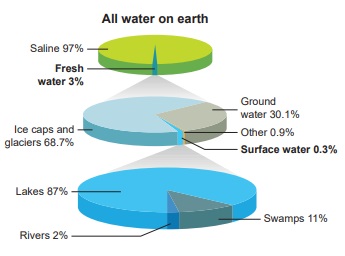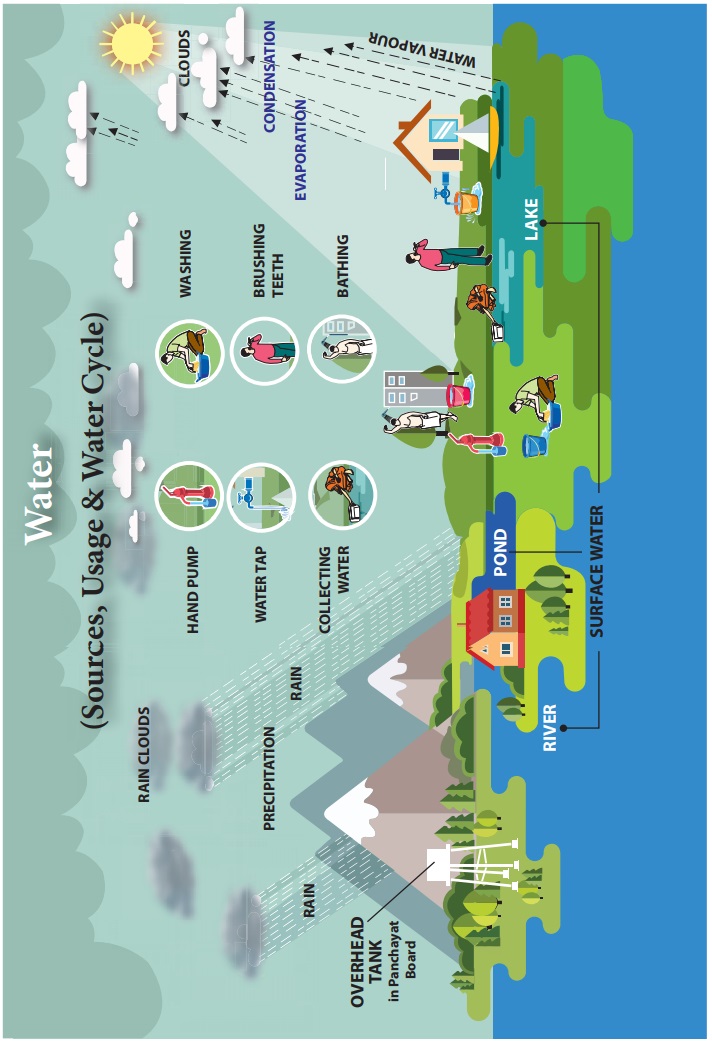Water | Term 3 Unit 2 | 6th Science - Availability of water | 6th Science : Term 3 Unit 2 : Water
Chapter: 6th Science : Term 3 Unit 2 : Water
Availability of water
Availability of water
We know that nearly ¾th of the surface of the earth is occupied by water. Most of the water, that is 97% of the total amount of water that exits on earth is found in seas and oceans.
Can we drink the water available in the sea?
Sea water is salty. But water used for our daily purposes is not salty. It is known as fresh water. Water obtained from ponds, puddles, river, tube-wells and taps at home is usually fresh water.
If the total water on earth be 100%, let’s see what percent would be the availability of fresh water.
Look at the pie chart given below.

From the pie chart, it can also be noted that 97% water is saline water. Only 3% found is the freshwater and that too in polar ice caps and glaciers. So this portion of water is not readily available for drinking.
The distribution of the totally available (3%) freshwater is as follows:
Polar ice caps and glaciers 68.7%
Ground water 30.1%
Other sources of water 0.9%
Surface water 0.3 %
The distribution of total 0.3% of surface water is as follows:
Lakes 87%
Rivers 2%
Swamps 11%
Thus the above pie chart explains that we have a very small amount of fresh water available for human usage and so maintaining the water table and the conservation of water is very essential. Isn’t it?
Water while passing through layers of soil dissolves salts and minerals to a maximum extent. These salts and minerals have been deposited in seas and oceans for millions of years and are still being deposited. In addition, the oceanic volcanoes which are present inside, also add salts to the sea. Water with large amounts of dissolved solids is not potable or suitable for drinking. Such water is called saline water.
Activity 1: Relative amount of water at various sources

Take a 20 litre bucket, a 500 ml mug, a 150 ml tumbler and a 1 ml spoon. If the capacity of the bucket is 20 litre, then it represents the total amount of water present on the Earth. Now, transfer a mug of water from the bucket and it is 500 ml and then it represents the total amount of fresh water present in the Earth. The water left in the bucket represents seas and oceans. This water is not fit for human use.
The water present in the mug represents the freshwater which is present in frozen form on snow-covered mountains, glaciers and polar ice caps. This water is also not readily available for human use. Next, transfer 150 ml of water to the tumbler, then it represents the total amount of ground water. Finally, take one-fourth spoonful of water while the capacity of the spoon is 1 ml, then it represents the total amount of surface water (i.e) water seen in all the rivers, lakes and ponds of the world. It can be taken as potable water.
When such a small amount of potable water is available, then we should be more cautious in handling water. Is it not?

Activity 2: Conduct the activity with common salt,sand, chalk powder, charcoal powder and copper sulphate.
Fill up the following table.


From the above activity we could observe that common salt and copper sulphate dissolve in water and contribute their properties like colour and other properties to water but sand, chalk powder and charcoal powder do not dissolve in water.
Related Topics